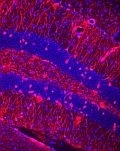Elizabeth Flandreau

Assistant Professor - Biological Psychology
- B.A. Biology, Lawrence University
- Ph.D. Neuroscience, Emory University
Office: 2129 Au Sable Hall
Phone: (616) 331-2527
Email: [email protected]
Specialization
Behavioral Neuroscience
Courses Taught
PSY 430 - Theories of Personality
PSY 330 - Foundations of Behavioral Neuroscience
PSY 300 - Research Methods
PSY 435 - Advanced Neuroscience and Behavior
Research Interests
Exposure to environmental stress increases the risk for neuropsychiatric disorders, most notably major depressive disorder (MDD), generalized anxiety disorder (GAD), and post-traumatic stress disorder (PTSD). As a stress neurobiologist, I conducted preclinical (animal model) research manipulating environment (social, predator, and/ or metabolic stress), gene-expression (viral vectors, transgenic animals), and circuit activity through drugs and measuring effects on behavior, circulating hormones, and gene-and protein expression within the brain (in situ hybridization or immunohistochemistry in brain slices, qPCR in dissected brain regions).
The big-picture goal of animal model research is to improve understanding, diagnosis, and treatment of humans with stress-sensitive disorders. Decades of stress neurobiology research in animal models identified signaling molecules and neuroanatomical pathways involved in the response to stress, yet we’ve seen little successful translation to improve the human condition.
One hurdle to translational success is the replication crisis in neuroscience. The cost of animal research in terms of time, money, and animals themselves motivates researchers (including myself) to minimize the number of animals in each experiment, resulting in underpowered findings where false positive results may be the rule rather than the exception (Button et al., 2013).
To address this crisis, human ‘omics’ research is shifting from small studies in homogeneous populations toward inter-institute collaborative consortia with large, diverse datasets. These consortia also benefit from multiple levels of scrutiny to reduce bias in analysis and publication. I have the privilege of working with collaborators at UCSD on the psychiatric genomics consortium for PTSD (PGC-PTSD) and VA Center for Excellence for Stress and Mental Health (CESAMH). My current project explores the relationship between the immune system and symptoms of PTSD.
Animal research has thus far failed to make a similar shift, but transparency and access to data has improved drastically with the open science movement. Researchers at University of Michigan developed a streamlined process of evaluating, cleaning, and combining open access (rodent) genomics data. Beyond turning underpowered data to proverbial gold, the “Brain Data Alchemy Project” (Hagenauer, et al, 2024) is devoted to training the next generation of scientists to ensure the existing replication crisis is… not replicated. The project is now formalized as a summer internship and I have the privilege of expanding my role from participant to mentor.
Publications
Eudave, D. M., BeLow, M. N., Flandreau, E. I. (2018). Effects of high fat or high sucrose diet on behavioral-response to social defeat stress in mice. Neurobiology of Stress, 9, 1-8.
Flandreau, E. I., & Toth, M. (2018). Animal Models of PTSD: A Critical Review. Current topics in behavioral neurosciences, 38, 47-68.
Toth, M., Flandreau, E. I., Deslauriers, J., Geyer, M. A., Mansuy, I. M., Merlo Pich, E., & Risbrough, V. B. (2016). Overexpression of Forebrain CRH During Early Life Increases Trauma Susceptibility in Adulthood. Neuropsychopharmacology : official publication of the American College of Neuropsychopharmacology, 41(6), 1681–1690.
Flandreau, E., Risbrough, V., Lu, A., Ableitner, M., Geyer, M. A., Holsboer, F., & Deussing, J. M. (2015). Cell type-specific modifications of corticotropin-releasing factor (CRF) and its type 1 receptor (CRF1) on startle behavior and sensorimotor gating. Psychoneuroendocrinology, 53, 16–28.
Toth, M., Gresack, J. E., Bangasser, D. A., Plona, Z., Valentino, R. J., Flandreau, E. I., Mansuy, I. M., Merlo-Pich, E., Geyer, M. A., & Risbrough, V. B. (2014). Forebrain-specific CRF overproduction during development is sufficient to induce enduring anxiety and startle abnormalities in adult mice. Neuropsychopharmacology : official publication of the American College of Neuropsychopharmacology, 39(6), 1409–1419.
Flandreau, E. I., Bourke, C. H., Ressler, K. J., Vale, W. W., Nemeroff, C. B., & Owens, M. J. (2013). Escitalopram alters gene expression and HPA axis reactivity in rats following chronic overexpression of corticotropin-releasing factor from the central amygdala. Psychoneuroendocrinology, 38(8), 1349–1361.
Sink, K. S., Walker, D. L., Freeman, S. M., Flandreau, E. I., Ressler, K. J., & Davis, M. (2013). Effects of continuously enhanced corticotropin releasing factor expression within the bed nucleus of the stria terminalis on conditioned and unconditioned anxiety. Molecular psychiatry, 18(3), 308–319.
Gafford, G. M., Guo, J. D., Flandreau, E. I., Hazra, R., Rainnie, D. G., & Ressler, K. J. (2012). Cell-type specific deletion of GABA(A)α1 in corticotropin-releasing factor-containing neurons enhances anxiety and disrupts fear extinction. Proceedings of the National Academy of Sciences of the United States of America, 109(40), 16330–16335.
Flandreau, E. I., Ressler, K. J., Owens, M. J., & Nemeroff, C. B. (2012). Chronic overexpression of corticotropin-releasing factor from the central amygdala produces HPA axis hyperactivity and behavioral anxiety associated with gene-expression changes in the hippocampus and paraventricular nucleus of the hypothalamus. Psychoneuroendocrinology, 37(1), 27–38.
